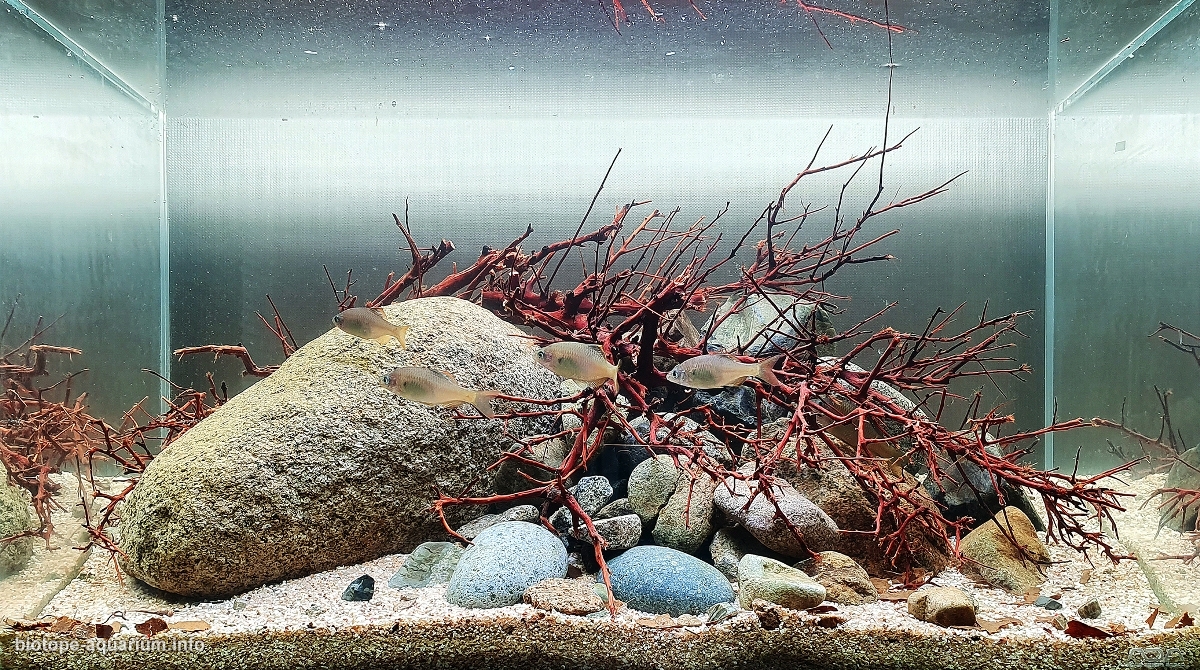Tributaries of the Nakdong River, Busan, South Korea
92th place in Biotope Aquarium Design Contest 2019
Korea. Kim Tea Hyun

Volume: 62 L
Dimensions: 60x36x30 cm
List of fishes: Acheilognathus korennsis, Rhinogobius brunneus , Paratya compressa ,Semisulcospira libertina
List of plants: Phragmites japonica ,Salvinia natans
Description of decorations: This unique species is native to Korea. It is a very rare fish species that lives only in rivers that flow to the West Sea south of Geumgang or the South Sea.
The body is 8cm long and it has a very unique breeding method. Between May and June, it spawns in the body of stone shells and shells living in freshwater.
Its habitat is built in the shallow middle and lower floors in the downstream area of the river. It is largely herded in the habitat. It is an omnivorous species, so it mainly eats aquatic insects and attached algae.
In order to resemble the natural environment as much as possible, stone and driftwood were brought from the habitat. In addition, the arrangement of the aquarium was arranged most similar to the natural environment.
Description of equipment: EHEIM classic 2211, Aqua Garden Light 60w, EHEIM aquarium heater 100w
Water parameters: Water temperature 22, P.H 6.5, T.D.S 138
Additional info: Water change at 30% twice a week.
8 hours a day of lighting.
The cooling system is fanned.
INFORMATION ABOUT BIOTOPE
Description of the area surrounding the biotope: The Nakdong River basin covers the entire Yeongnam region and flows to the South Sea through the lowlands of the center of Yeongnam region. The river extends 521.5 km and the watershed area is 23,817 km 2, which is the largest river in Korea except for the Yalu River.
The Nakdong River is composed of various topography and water depth structures. The upper stream of the Nakdong River mainly consists of cobbled terrains, and as it goes downstream, many terrains, such as forests and sandy beaches, are revealed.
Around the riverside, there are walkways and rest areas where people can take a break.
Description of the underwater landscape of the biotope: The species inhabits a region near downstream with week current and shallow water, bank of stream and pond near the river. It travels in some small flocks swimming in the middle and lower floors of a lot of waterfalls. It is an omnivorous species, so it mainly eats aquatic insects and attached algae
Description of the parameters of the habitat: Water temperature varies from 27 degrees in summer to 5 degrees in winter
P.H 5.5~7.0
T.D.S 138
List of fishes and invertebrates occurring in the nature biotope: Acheilognathus korennsis , Moroco oxycephalus ,Zacco temmincki ,Zacco platypus , Cyprinus carpio , Carassius carassius ,Pseudorasbora parva , Hemibarbus labeo, Culter brevicauda , Fluta alba , Korean rose bitterling
,Coreoleuciscus splendidus ,Hemiculter eigenmanni , Korean bullhead , Hypomesus olidus
List of plants found in the nature biotope: Typha angustata ,Monochoria koraskowi ,Euryale ferox ,Trapa japonica ,Hydro charis dubia ,Salvinia natans ,Poramogeton malaianus var. latifolius ,Hydrilla verticillata
Threats to the ecology: The Nakdong River gets dirty especially as it goes downstream.
The reason for this can be seen from the layout of the cities in the upper, middle, and downstream basins. Upstream cities are all agriculture-oriented small cities only producing few pollutants, which has little effect on the river. However, it gets dirty as it passes through some large industrial cities of the middle class, for example, Gumi City and Daegu Metropolitan City. Furthermore, the contamination becomes more serious as the river passes through some cities with large population such as Changwon City, Gimhae City and Yangsan City.
Some serious pollution accidents are frequently derived by leakage of dangerous chemicals as the river passes through industrial complexes.
For examples, in 1991, a phenol spill occurred and three years later in early 1994, there was a stinking odor in the tap water of Daegu, Masan, and Busan.
Toluene and benzene, which are carcinogenic substances, were detected in Daegu, Masan and Busan water purification plants, which were also found to have been leaked from the Nakdong River Water Industrial Complex.
In 2009, the suspected carcinogenic substance, 1,4-dioxane, was leaked from the Gumi Industrial Complex to the Nakdong River.
However, many NGOs and governments are making efforts to improve water quality.
Sources of information:
http://www.me.go.kr/ndg/web/
http://www.me.go.kr/ndg/web/
https://www.busan.go.kr/
